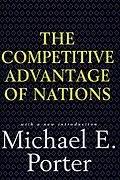Now beyond its eleventh printing and translated into twelve languages, Michael Porter's The Competitive Advantage of Nations has changed completely our conception of how prosperity is created and sustained in the modern global economy. Porter's groundbreaking study of international competitiveness has shaped national policy in countries around the world. It has also transformed thinking and action in states, cities, companies, and even entire regions such as Central America.
Based on research in ten leading trading nations, The Competitive Advantage of Nations offers the first theory of competitiveness based on the causes of the productivity with which companies compete. Porter shows how traditional comparative advantages such as natural resources and pools of labor have been superseded as sources of prosperity, and how broad macroeconomic accounts of competitiveness are insufficient. The book introduces Porter's ?diamond,? a whole new way to understand the competitive position of a nation (or other locations) in global competition that is now an integral part of international business thinking. Porter's concept of ?clusters,? or groups of interconnected firms, suppliers, related industries, and institutions that arise in particular locations, has become a new way for companies and governments to think about economies, assess the competitive advantage of locations, and set public policy.
Even before publication of the book, Porter's theory had guided national reassessments in New Zealand and elsewhere. His ideas and personal involvement have shaped strategy in countries as diverse as the Netherlands, Portugal, Taiwan, Costa Rica, and India, and regions such as Massachusetts, California, and the Basque country. Hundreds of cluster initiatives have flourished throughout the world. In an era of intensifying global competition, this pathbreaking book on the new wealth of nations has become the standard by which all future work must be measured.
Autorentext
Michael E. Porter
Inhalt
Contents
Introduction
Preface
Chapter 1 Competitive Strategy: The Core Concepts
THE STRUCTURAL ANALYSIS OF INDUSTRIES
Industry Structure and Buyer Needs
Industry Structure and the Supply/Demand Balance
GENERIC COMPETITIVE STRATEGIES
Cost Leadership
Differentiation
Focus
Stuck in the Middle
Pursuit of More Than One Generic Strategy
Sustainability
Generic Strategies and Industry Evolution
Generic Strategies and Organizational Structure
Generic Strategies and the Strategic Planning Process
OVERVIEW OF THIS BOOK
PART I PRINCIPLES OF COMPETITIVE ADVANTAGE
Chapter 2 The Value Chain and Competitive Advantage
THE VALUE CHAIN
Identifying Value Activities
Defining the Value Chain
Linkages within The Value Chain
Vertical Linkages
The Buyer's Value Chain
COMPETITIVE SCOPE AND THE VALUE CHAIN
Segment Scope
Vertical Scope
Geographic Scope
Industry Scope
Coalitions and Scope
Competitive Scope and Business Definition
The Value Chain and Industry Structure
THE VALUE CHAIN AND ORGANIZATIONAL STRUCTURE
Chapter 3 Cost Advantage
THE VALUE CHAIN AND COST ANALYSIS
Defining the Value Chain for Cost Analysis
Assigning Costs and Assets
First Cut Analysis of Costs
COST BEHAVIOR
Cost Drivers
The Cost of Purchased Inputs
Segment Cost Behavior
Cost Dynamics
COST ADVANTAGE
Determining the Relative Cost of Competitors
Gaining Cost Advantage
Sustainability of Cost Advantage
Implementation and Cost Advantage
Pitfalls in Cost Leadership Strategies
STEPS IN STRATEGIC COST ANALYSIS
Chapter 4 Differentiation
SOURCES OF DIFFERENTIATION
Differentiation and The Value Chain
Drivers of Uniqueness
THE COST OF DIFFERENTIATION
BUYER VALUE AND DIFFERENTIATION
Buyer Value
The Value Chain and Buyer Value
Lowering Buyer Cost
Raising Buyer Performance
Buyer Perception of Value
Buyer Value and the Real Buyer
Buyer Purchase Criteria
Identifying Purchase Criteria
DIFFERENTIATION STRATEGY
Routes to Differentiation
The Sustainability of Differentiation
Pitfalls in Differentiation
STEPS IN DIFFERENTIATION
Chapter 5 Technology and Competitive Advantage
TECHNOLOGY AND COMPETITION
Technology and The Value Chain
Technology and Competitive Advantage
Technology and Industry Structure
TECHNOLOGY STRATEGY
The Choice of Technologies to Develop
Technological Leadership or Followership
Licensing of Technology
TECHNOLOGICAL EVOLUTION
Continuous Versus Discontinuous Technological Evolution
Forecasting Technological Evolution
FORMULATING TECHNOLOGICAL STRATEGY
Chapter 6 Competitor Selection
THE STRATEGIC BENEFITS OF COMPETITORS
Increasing Competitive Advantage
Improving Current Industry Structure
Aiding Market Development
Deterring Entry
WHAT MAKES A "GOOD" COMPETITOR?
Tests of a Good Competitor
"Good" Market Leaders
Diagnosing Good Competitors
INFLUENCING THE PATTERN OF COMPETITORS
Damaging Good Competitors in Battling Bad Ones
Changing Bad Competitors into Good Ones
THE OPTIMAL MARKET CONFIGURATION
The Optimal Competitor Configuration
Maintaining Competitor Viability
Moving toward the Ideal Competitor Configuration
Maintaining Industry Stability
PITFALLS IN COMPETITOR SELECTION
PART II COMPETITIVE SCOPE WITHIN AN INDUSTRY
Chapter 7 Industry Segmentation and Competitive Advantage
BASES FOR INDUSTRY SEGMENTATION
Structural Bases For Segmentation
Segmentation Variables
Finding New Segments
THE INDUSTRY SEGMENTATION MATRIX
Relationships Among Segmentation Variables
Combining Segmentation Matrices
INDUSTRY SEGMENTATION AND COMPETITIVE STRATEGY
The Attractiveness of a Segment
Segment Interrelationships
Segment Interrelationships and Broadly-Targeted Strategies
The Choice of Focus
The Feasibility of New Segments to Focus On
The Sustainability of a Focus Strategy
Pitfalls and Opportunities for Focusers and Broadly-Targeted Competitors
INDUSTRY SEGMENTATION AND INDUSTRY
DEFINITION
Chapter 8 Substitution
IDENTIFYING SUBSTITUTES
THE ECONOMICS OF SUBSTITUTION
Relative Value/Price
Switching Costs
Buyer Propensity to Substitute
Segmentation and Substitution
CHANGES IN THE SUBSTITUTION THREAT
Substitution and Overall Industry Demand
Substitution and Industry Structure
THE PATH OF SUBSTITUTION
Segmentation and the Substitution Path
Substitution Forecasting Models
SUBSTITUTION AND COMPETITIVE STRATEGY
Promoting Substitution
Defense Against Substitutes
Industry Versus Firm Substitution Strategy
Pitfalls in Strategy Against Substitutes
PART III CORPORATE STRATEGY AND COMPETITIVE ADVANTAGE
Chapter 9 Interrelationships among Business Units
THE GROWING IMPORTANCE OF HORIZONTAL STRATEGY
INTERRELATIONSHIPS AMONG BUSINESS UNITS
TANGIBLE INTERRELATIONSHIPS
Sharing and Competitive Advantage
The Costs of Sha…
